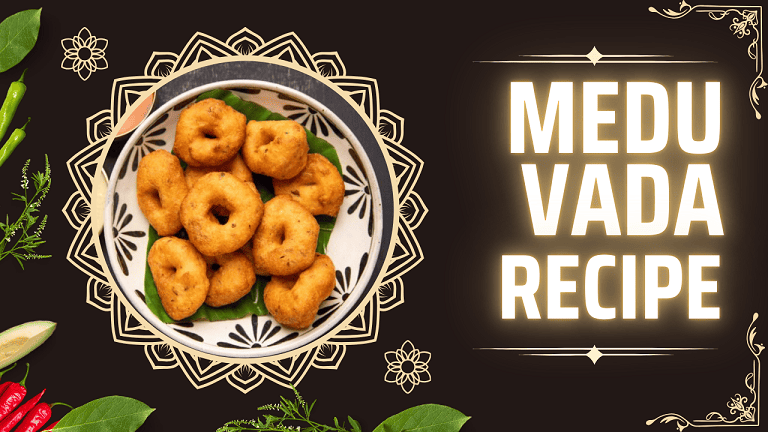Medu Vada Recipe
Medu Vada, a popular South Indian delicacy, is a savory doughnut-shaped fritter made from urad dal (black gram lentils). Known for its crispy exterior and soft, fluffy interior, medu vada is a staple in South Indian households and is often served for breakfast, as a snack, or alongside a hearty meal.
Traditionally served with sambar (a lentil-based vegetable stew) and coconut chutney, this dish holds significant cultural importance in Indian cuisine.
Medu Vada is not only delicious but also highly nutritious. Urad dal is an excellent source of protein, fiber, and essential minerals such as iron and magnesium, making this dish perfect for vegetarians looking for a wholesome and filling meal.
When made with locally sourced ingredients like fresh herbs, spices, and vegetables, it becomes a flavorful and nutritious option.
Health Benefits
Urad dal, the key ingredient in medu vada, is rich in protein and dietary fiber, promoting digestive health and providing sustained energy. The use of minimal oil and the option to incorporate vegetables into the batter adds more nutrients to this recipe.
Additionally, by using cold-pressed oils, fresh herbs, and spices like cumin and curry leaves, this dish offers anti-inflammatory and antioxidant benefits.
Ingredients (For 15-20 Vadas)
For the Vada Batter:
- Urad dal (black gram lentils) – 1 cup (200g)
- Green chilies – 2-3, finely chopped (adjust based on spice preference)
- Ginger – 1-inch piece, finely chopped or grated
- Curry leaves – 8-10 leaves, finely chopped
- Fresh coriander (cilantro) – 2 tablespoons, finely chopped
- Black peppercorns – 1 teaspoon, coarsely crushed
- Cumin seeds (jeera) – 1 teaspoon
- Onion – 1 small, finely chopped (optional)
- Salt – 1 teaspoon, or to taste
- Water – As required, for grinding
- Cold-pressed coconut oil or sesame oil – For frying (use as required)
Optional Add-ins for Extra Nutrition:
- Grated carrots – ¼ cup (adds sweetness and nutrients)
- Chopped spinach – ¼ cup (for added fiber and iron)
- Asafoetida (hing) – A pinch (aids in digestion)
Step-by-Step Instructions
Soak the Urad Dal:
Rinse the urad dal thoroughly under running water and soak it in fresh water for at least 4-5 hours or overnight. This soaking process softens the dal, making it easier to grind and ensuring a smooth batter consistency.
Tip: If you’re short on time, soak the dal in warm water for 2 hours, though longer soaking yields better results.
Prepare the Batter:
Drain the soaked urad dal and transfer it to a mixer or food processor. Add just enough water to grind the dal into a smooth, thick batter. The batter should be light and fluffy, not too runny.
Tip: To test if your batter has the right consistency, drop a small amount in water. If it floats, the batter is aerated and ready for frying.
Incorporate Flavorings:
Transfer the ground batter to a large mixing bowl. Add chopped green chilies, ginger, curry leaves, fresh coriander, crushed black peppercorns, cumin seeds, and salt. Stir gently to combine. If you’re using optional ingredients like grated carrots or spinach, fold them into the batter as well.
Tip: Avoid overmixing the batter at this stage to retain its light, airy texture.
Shape the Vadas:
Wet your hands with water to prevent the batter from sticking. Take a small portion of the batter, roughly the size of a golf ball, and gently shape it into a round patty. Use your thumb to make a small hole in the center to create the classic doughnut shape.
Tip: If shaping vadas by hand feels tricky, use a small ladle or spoon to drop dollops of batter into the hot oil directly.
Fry the Vadas:
Heat coconut oil or sesame oil in a deep frying pan over medium heat. To test if the oil is ready, drop a small piece of batter into the oil; if it sizzles and rises to the surface, the oil is hot enough.
Gently slide the shaped vadas into the hot oil, taking care not to overcrowd the pan. Fry them in batches to maintain the oil temperature. Fry each vada until golden brown and crispy on the outside, turning occasionally for even cooking. This should take about 4-5 minutes per batch.
Tip: Maintain a steady medium heat. Too high a temperature will brown the outside too quickly, leaving the inside undercooked.
Drain and Serve:
Once the vadas are golden and crispy, use a slotted spoon to remove them from the oil and place them on a paper towel-lined plate to drain any excess oil.
Nutritional and Flavor Tips
Light and Fluffy Vadas: The key to achieving light and fluffy medu vadas is to ensure the batter is well-aerated. The urad dal must be ground into a smooth, thick paste, and the batter should be whipped slightly to incorporate air. This helps create a vada that is soft on the inside and crispy on the outside.
Minimize Oil Absorption: To reduce oil absorption during frying, ensure the oil is at the right temperature before adding the vadas. If the oil is too cool, the vadas will absorb excess oil, making them greasy.
Add Veggies for Extra Nutrition: Grated carrots, chopped spinach, or finely diced bell peppers can be added to the batter for extra nutrients. These vegetables not only boost the nutritional profile but also add flavor and color to the vadas.
Variations and Substitutions
Baked Medu Vada:
For a healthier alternative, you can bake the vadas instead of deep frying. Preheat the oven to 200°C (400°F), grease a baking tray or use a silicone baking mat, and place the vada batter portions on the tray. Bake for about 25-30 minutes, flipping halfway through, until they are golden brown and crisp.
Gluten-Free Option:
Medu vada is naturally gluten-free since urad dal is the primary ingredient. Just ensure that the spices and any added ingredients like asafoetida (hing) are gluten-free.
Vegan Option:
Medu vada is inherently vegan as it doesn’t contain dairy or animal products. To make it even more plant-based friendly, serve it with coconut chutney or vegan sambar, avoiding any dairy-based condiments.
No Onion-Garlic Version:
If you’re following a satvik diet (which excludes onion and garlic), simply omit these ingredients. You can enhance the flavor by adding more herbs like curry leaves and coriander.
Lentil Mix Vada:
For a variation in flavor and texture, mix urad dal with other lentils like yellow moong dal or chana dal. This adds a unique crunch to the vadas and increases the protein content.
Serving Suggestions
Traditional South Indian Meal:
Serve medu vada with steaming hot sambar and a side of coconut chutney for a classic South Indian breakfast or meal. Add a small serving of tangy tomato chutney for extra flavor contrast.
Festival or Celebration Platter:
During festivals like Pongal or Diwali, medu vada is often part of a larger feast. You can serve it alongside idli, dosa, or uttapam with a variety of chutneys, sambars, and rasam. The vadas can also be served as an appetizer before the main meal.
Vada Pav:
For a fusion twist, serve the medu vada in a pav (Indian bread roll) with a tangy chutney, much like the popular vada pav. This is a unique way to enjoy vada as a sandwich-style snack.
Healthy Snack:
Serve medu vada as a healthy, protein-packed snack with a side of fresh coconut chutney made from grated coconut, green chilies, and a touch of tamarind. Pair it with a glass of freshly squeezed juice or buttermilk for a balanced meal.
Presentation Tips
Garnish with Fresh Herbs: Just before serving, sprinkle finely chopped coriander leaves and curry leaves over the medu vadas to add a burst of freshness and color.
Serve on Banana Leaves: For a traditional presentation, serve medu vada on banana leaves. This not only adds a rustic touch but also enhances the overall dining experience, as banana leaves are believed to impart a subtle aroma to the food.
Mini Vada Appetizers: Shape the medu vadas into smaller, bite-sized portions and serve them as appetizers at gatherings. Pair them with a trio of dips, such as coconut chutney, tomato chutney, and mint-coriander chutney, for a fun and interactive serving style.
Conclusion
Medu vada, with its simple yet flavorful ingredients, remains a timeless dish in Indian cuisine. Whether enjoyed as a breakfast item, snack, or part of a festive feast, this savory fritter offers a balance of nutrition and taste.
By using locally sourced ingredients like urad dal, fresh herbs, and vegetables, medu vada not only celebrates the rich agricultural diversity of India but also ensures maximum nutritional benefits.
The beauty of this dish lies in its versatility—whether you’re indulging in the traditional deep-fried version or experimenting with healthier alternatives like baking, medu vada fits well into a balanced vegetarian diet.
By incorporating variations such as adding vegetables or making it gluten-free or vegan, medu vada can cater to a wide range of dietary preferences. Its cultural significance in South Indian festivals, family gatherings, and everyday meals underscores its place in the culinary heart of India.
Final Serving and Presentation Tips:
Chutney Variations: To elevate the serving experience, pair the medu vada with a variety of chutneys. Aside from the traditional coconut chutney, try serving it with a tangy tamarind chutney or a spicy red chili chutney. These chutneys provide a vibrant flavor contrast to the savory vadas.
Plate Presentation: Arrange the medu vadas neatly on a large serving platter, garnished with fresh coriander and curry leaves. You can also place a small bowl of sambar and chutney in the center of the plate for a cohesive presentation.
Festive Serving: For festivals and special occasions, serve medu vada as part of a grand thali (platter), surrounded by other South Indian delicacies like idli, pongal, and dosa, along with a variety of chutneys and side dishes.
This setup not only showcases the vada’s cultural importance but also allows your guests to enjoy a wholesome, traditional meal.
In conclusion, medu vada is a dish that has stood the test of time. Its simplicity, coupled with its nutritional benefits, makes it a beloved favorite across India.
Whether you prepare it for a festive occasion, a family breakfast, or as a snack, medu vada brings together the essence of vegetarian cooking—delicious, nutritious, and deeply satisfying.
By sourcing fresh, local ingredients, you can create a dish that not only honors tradition but also prioritizes health and sustainability.
Thanks for visiting Veg Recipe

